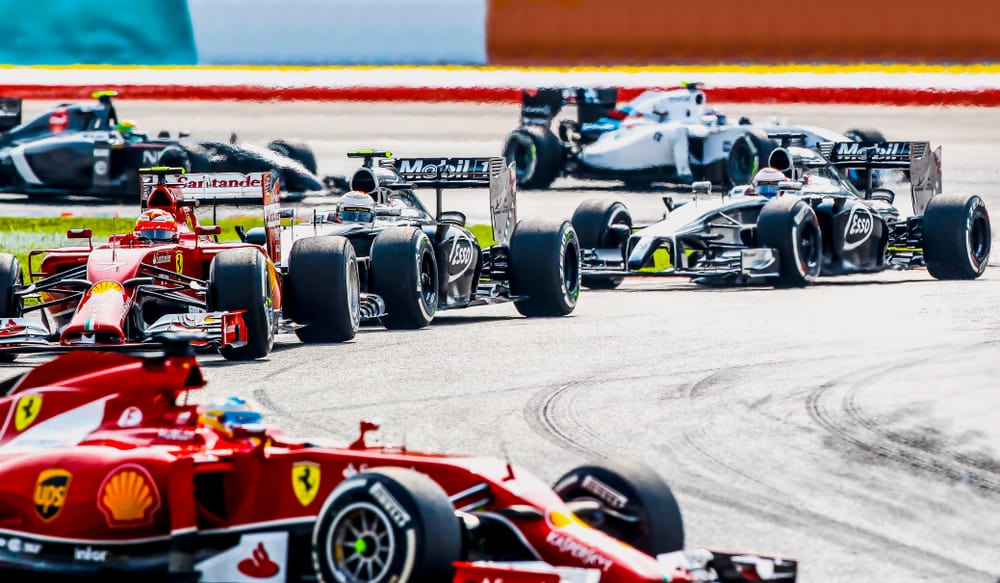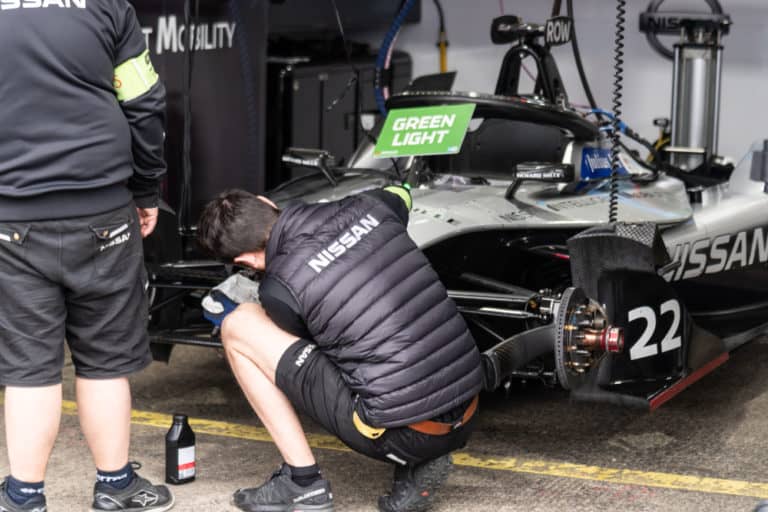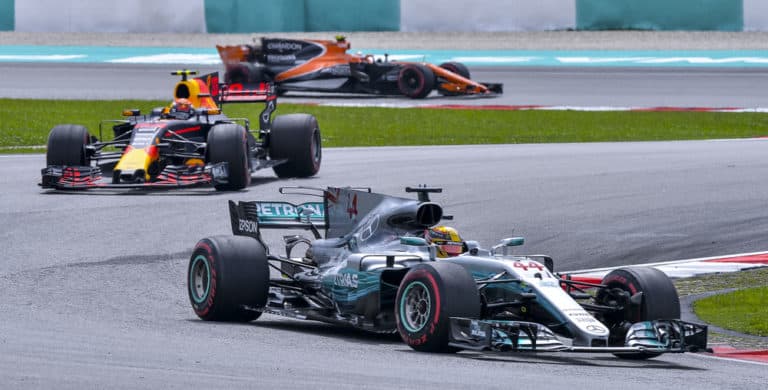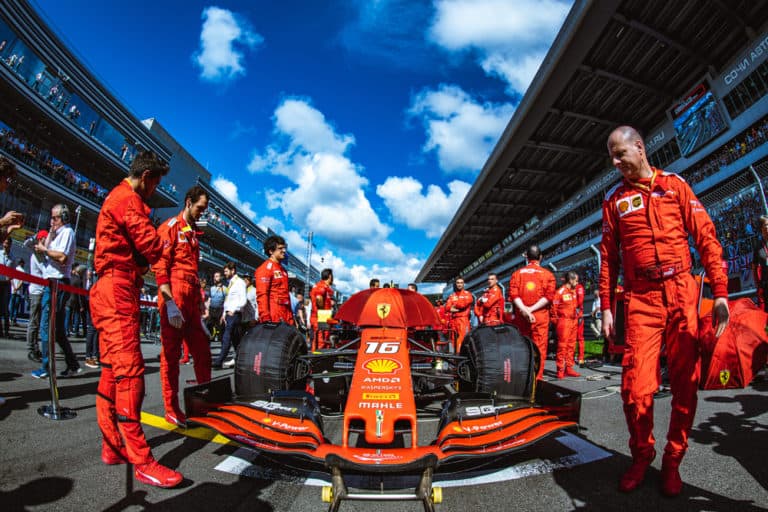Formula racing is defined specifically as open-wheeled, single-seater, motorsport road racing, particularly with four-wheeled cars. This, however, is a somewhat ambiguous statement, as there are several forms of formula racing. The most important of which are Formula 1, Formula 2, and Formula 3, but what is the difference between these formats?
F1, F2, and F3 are all Formula racing leagues. F1 is the fastest, most expensive, and most prestigious. F2 and F3 run less powerful cars, but more drivers and are very exciting races. F1 is the ultimate Formula racing league. Some F2 and F3 drivers are promoted to Formula 1 if they have the skill.
Formula racing is among the most intense and most prestigious in the world. Motorsport would simply not be as exciting without these exciting racing leagues. Let’s highlight take the time to explore each of the three main Formula racing leagues, F1, F2, and F3, to better understand them and highlight the differences between them.
If you’re looking for some F1 merchandise, check out the awesome stuff at the official F1 store here.
What Is F1, F2, and F3 Racing?
F1, F2, and F3 can be confusing at first, but upon closer inspection, it is clear to see that these racing formats are very different.
F1, F2, and F3 are all types of Formula motorsport racing leagues. F3 is the high-end of junior racing, F2 is a little more intense, and the drivers are on their way out of amateur status, and F1 is the highest league with the most intensity, the highest speeds, the best drivers, and the biggest budgets.
Formula racing is very expensive and extremely competitive. The driers race in open-wheeled, single-driver cars around some of the most dangerous racing tracks in the world, t some of the fastest speeds possible in motorsport.
The racing format between these three race leagues is largely similar, but there is some key difference to note. F1 is the biggest, most prestigious, and fastest version of Formula racing.
These cars are the biggest, with the most power and performance, and the drivers are the most skilled. F1 cars are significantly faster than the other leagues in Formula racing, and the teams have significantly larger budgets, allowing for more intense competition.
F1 has 20 drivers per race from 10 separate racing teams. This is different from other Formula racing types that have more drivers per race.
Formula 2 I slightly slower and smaller than Formula 1, and Formula 3 is slightly slower and smaller still. Formula 3 is more of a junior racing league, but the racing is still fast and intense.
Many motorsport fans enjoy watching the lower levels of the Formula racing league because the racing is very close and very intense. Formula 3, for example, has 30 drivers per race, and the rules in this league are laid out to change the driver lineup over the two-race event to make racing fairer.
This leads to a lot of spectacle on the racetrack that is very enjoyable for spectators.
All of these comparisons are very broad, but these are more general descriptions of the races to begin to highlight what they are like and what their differences are.
This is because all Formula races must follow very strict rules and regulations. All Formula racing must follow the rules regarding the build and performance of the car, the parameters of the race, the scoring and points system, the racing regulations regarding competition, and many other factors that teams and drivers must adhere to.
Let’s take the time to go a little deeper into each of these types of Formula racing, to define what they are, and to define how they compare to one another on a much more focused level rather than the broad comparisons that we have made already.
Formula 3: The Important Information
Formula 3 is the highest junior league in Formular motorsport. These teams and drivers in this league must conform to very strict rules and regulations. Let’s highlight some of the important regulations in F3 and detail some of the defining features of this league compared to F2 and F1.
The F3 Race Car
The car that drivers use in Formula 1 must adhere to specific regulations to be allowed to compete in the race.
F3 cars must use stock-derived, 6-cylinder naturally aspirated engines with a 3.4-liter capacity and a 28mm width restrictor. These engines produce around 380 horsepower and are fueled by gasoline that is comparable to that of a normal road car. All F3 cars are made with the exact same chassis.
The cars have a minimum weight of 550kg, including the driver, they must have rear-wheel drive and two-wheel steer only, a sequential gearbox with a maximum of 6 gears excluding reverse, and must have no more or less than 45 liters of onboard fuel capacity.
The cars in F3 are capable of reaching a speed of 300km/h and accelerate to 100km/h in 3.1 seconds.
F3 Racing Format
Formula 3 races are held over a weekend, as are the other Formula race league races. However, Formula 3 has a slightly different format than the other leagues.
F3 events consist of a practice session and a qualifying session on Friday. Saturday holds two races. The starting positions for the first race are determined by the qualifying sessions, but the first 12 positions on the grid are reversed. This means that the drivers who qualify 12th will start in pole position.
The starting positions for the second race are determined by the finishing positions of the first race, also with the reverse-pole structure for the top 12 drivers.
The third race takes place on Sunday, ad this race is held with the starting positions incorrect order from the qualifying sessions.
F3 Scoring System
The F3 scoring system is more straightforward than the race structure. The first 10 drivers to finish the race are awarded points, regardless of their starting positions.
The points decrease from first place to tenth place, and there are an additional 4 points awarded to the driver who achieves pole position for race 3 and an additional 2 points for the racing driver who achieves the fastest lap time in any race of the race provided they finish in the top ten positions.
The points are awarded as follows for the 3 races in the F3 race weekend.
Race 1 and race 2 points:
| 1st Place | 15 Points |
| 2nd Place | 12 Points |
| 3rd Place | 10 Points |
| 4th Place | 8 Points |
| 5th Place | 6 Points |
| 6th Place | 5 Points |
| 7th Place | 4 Points |
| 8th Place | 3 Points |
| 9th Place | 2 Points |
| 10th Place | 1 Point |
| Fastest Lap | 2 Points |
Race 3 points:
| 1st Place | 25 Points |
| 2nd Place | 18 Points |
| 3rd Place | 16 Points |
| 4th Place | 12 Points |
| 5th Place | 10 Points |
| 6th Place | 8 Points |
| 7th Place | 6 Points |
| 8th Place | 4 Points |
| 9th Place | 2 Points |
| 10th Place | 1 Point |
| Pole Position | 4 Points |
| Fastest Lap | 2 Points |
The points are awarded to the drivers according to the race results. The drivers’ points are added up to determine the winner of the Drivers’ Championship at the end of the racing season.
Each team is allowed to have three drivers represent them on track. The points that each driver wins combine for the total points awarded to the team. The team with the most awarded points at the end of the racing season wins the Teams’ Championship.

Formula 2: The Important Information
Formula 2 is a step up from Formula 3, but it is still not quite as intense as Formula 1. That being said, everything in F2 is faster, more intense, and more prestigious than F3.
Here is the important information that you need to know when comparing F2 to F3 and F1.
The F2 Race Car
In Formula 2, the cars are more powerful and faster than the cars in Formula 3.
The F2 race car is equipped with a 620 HP 3.4 liter V6 with a single turbo. These engines propel the cars up to speeds of 335km/h and enable the car to reach a speed of 100km/h in 2.9 seconds or less.
The minimum weight of an F2 car must be 755kg, including the driver. All F2 cars use the same carbon fiber chassis; they are equipped with a 6-speed sequential gearbox, rear-wheel drive and front-wheel steering, 125 liters of fuel, and sophisticated electronic systems and suspension.
F2 Racing Format
Formula 2 has a unique racing format in the Formula race series. The F2 race event takes place over a weekend; as with the other Formula leagues, there is practice and qualifying on Friday, but there are two sprint races held on Saturday and a feature race on Sunday.
The qualifying determines the starting order of the first Saturday sprint race and the feature race on Sunday. The first Saturday sprint uses the same reverse order as F3, but only for the top 10 drivers rather than the top 12.
The feature race on Sunday is longer and more important than the sprint races held on Saturday, and the starting positions of the drivers are in order of the Friday qualifying results.
F2 Scoring System
The points scoring system in Formula 2 is precisely the same as the points system in Formula 3.
The top 10 drivers in the race are awarded points for their race position finish. The points awarded decrease from first place to tenth place, and any driver finishing lower than tenth place is not awarded any points.
More points are awarded for the feature race than for the sprint races, and the same bonus points are awarded to the drivers who complete the fastest lap and start in pole position, provided they finish the race in the top 10.
There are 11 teams in the F2 2021 season, each with two drivers per team. The points awarded to the drivers are allocated to the team overall. The driver with the most points at the end of the season wins the Drivers’ Championship, and the racing team with the most points will win the Teams’ Championship.
Formula 1: The Important Information
Formula 1 is the biggest, fastest, most intense, most prestigious, and most expensive form of Formula racing. This sport is among the most popular, the most expensive, and the most highly regarded motorsports in the world. Many regard F1 to be the antithesis of motor racing.
These are bold statements, but only Formula 1 can claim to hold true to any of them. Let’s go over the important information required to compare F1 to the lower Formula racing leagues.
The F1 Race Car
The F1 race car is the biggest, fastest, and most powerful car in Formula racing.
The race cars in F1 are equipped with 1.6 liter V6 hybrid turbocharged engines with up to 1000 horsepower. The cars are capable of race speeds in the range of 370km/h, only take 2.6 seconds to achieve 100km/h, and are the most efficient engines in Formula 1 history.
These cars are permitted to carry 145 liters of specialized fuel. The F1 car is permitted to use unique chassis and racing setups; they must weigh a minimum of 740kg, including the driver, and they are equipped with 9-speed seamless-shift semi-automatic sequential gearboxes.
These engines are not the most powerful in F1 history, but they are the most efficient and offer the most performance by weight and size in F1 history.
F1 Racing Format
The Formula 1 racing format takes place over a full weekend for each event. Friday holds free practice for each team and drive, Saturday hosts a qualifying session that determines the starting order of the feature Grand Prix race, and Sunday holds the feature Formula 1 Grand Prix race in the order determined by the qualifying session.
There are no reverse-order configurations in Formula 1.
Some race events use the sprint qualifying format, but not every race in the season uses this format.
F1 Scoring System
Points in Formula 1 are only awarded for the top ten drivers in the feature Sunday race. There are extra points awarded for drivers who qualify in the top three positions if there is a sprint qualifying for the event, and there is an extra point awarded to the driver with the fastest lap of the given race, provided that they finish within the top ten.
The points awarded in F1 are as follows:
| 1st Place | 25 Points |
| 2nd Place | 18 Points |
| 3rd Place | 16 Points |
| 4th Place | 12 Points |
| 5th Place | 10 Points |
| 6th Place | 8 Points |
| 7th Place | 6 Points |
| 8th Place | 4 Points |
| 9th Place | 2 Points |
| 10th Place | 1 Point |
| Fastest Lap | 1 Point |
Conclusion
Formula racing is some of the most competitive and most challenging racing in motorsport.
Formula 2 and Formula 3 are feeder leagues for Formula 1, and many of the drivers in these formats find their way into F1 if they have the skill to compete.
These races are fast, intense, and expensive, but Formula 1 is the fastest, most intense, and most expensive of them all. The lower leagues offer very exciting racing for spectators because the races are designed to focus on driver talent rather than the ability of the cars that they drive.
There are fewer limits in F1, and the cars do play an important role in winning races, but the skill of the driver is the most important aspect for every team.
If you are a fan of one of these Formula racing formats, you are likely to thoroughly enjoy the others as well. Give them a try, watch the highlights of each race, and enjoy all forms of Formula racing rather than only following one league!
References
- https://en.wikipedia.org/wiki/2021_Formula_2_Championship
- https://en.wikipedia.org/wiki/2021_FIA_Formula_3_Championship#Scoring_system
- https://en.wikipedia.org/wiki/2021_Formula_One_World_Championship
- https://www.essentiallysports.com/what-is-the-difference-between-formula-one-f2-and-f3/
- https://www.autosport.com/f1/news/how-fast-is-an-f1-car-top-speeds-of-f1-indycar-motogp-and-more-4980734/4980734/
- https://en.wikipedia.org/wiki/Formula_One_car#Engines
- https://www.chaseyoursport.com/Formula-1/What-is-the-difference-between-Formula-1-F2-F3-and-FE/2128
- https://www.fiaformula2.com/About/14LCsEEMG9yyx5DkhcN1J8/the-car-and-engine-f2






